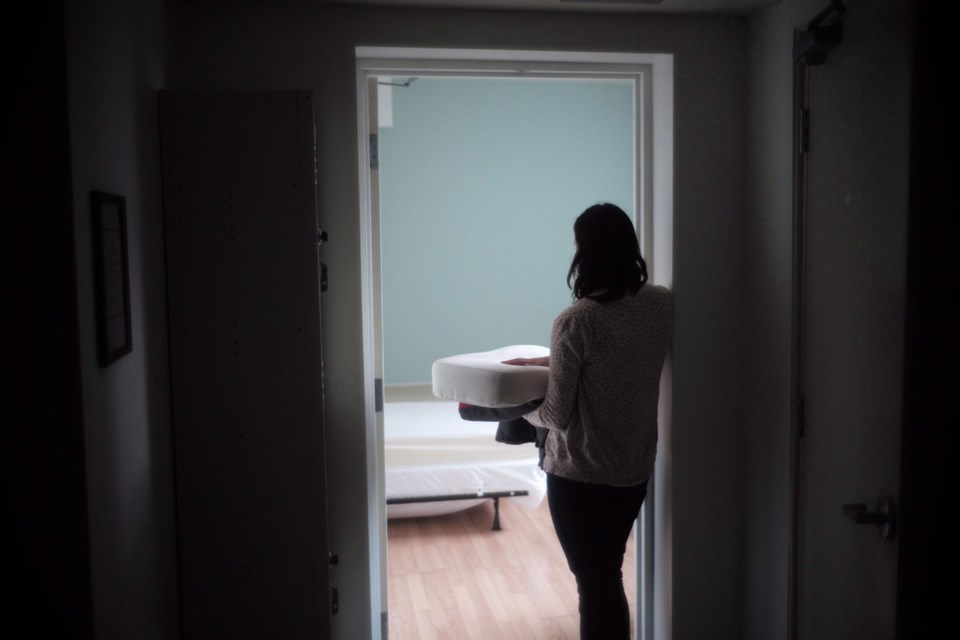HALIFAX ŌĆö WomenŌĆÖs advocates say provincial and federal governments need to step up efforts to create housing for people escaping gender-based violence because too many women are forced to remain in unsafe situations after being abused.
A study released last week by WomenŌĆÖs Shelters Canada says the countryŌĆÖs housing crisis is preventing many people from finding affordable and safe housing after leaving their abuser.
Of the 381 shelters and transition houses that responded, 94 per cent of emergency shelters and 83 per cent of transition homes said victims were staying longer than they had in the past while searching for housing.
The report also said when people do leave the facilities, about half return to their abusers because they have no other options. More than two-thirds of the women end up in housing situations considered precarious, which meant they were living with friends or families or trading work for rent. A full 36 per cent experience homelessness at some point.
Anna Morgan, manager of programs and services at ErnestineŌĆÖs WomenŌĆÖs Shelter in Etobicoke, Ont., says her organization has seen enormous demand for services as rents in the Greater Toronto Area soar. Her shelter is meant to provide short-term accommodation for women escaping violence, but it has become more like a transition house as people struggle to find a new place to live.
ŌĆ£WeŌĆÖre over capacity,ŌĆØ Morgan said in a phone interview this week. ŌĆ£The shelter system is becoming basically transitional housing for people, and they (the shelters) are really not set up to be housing.ŌĆØ She said the shelter had to turn away 312 people in the fiscal year that ended March 31, and it is on track to turn away a high number again this year.
The shelter helps women and gender-diverse people from all racial and ethnic backgrounds. Many people come from the GTA and neighbouring communities, but Morgan says sometimes people arrive from out of province or even as refugees.
The vast majority of people coming to the shelter are ŌĆ£deeply poor,ŌĆØ she says, either on social assistance or working minimum wage jobs.
The average rent in Toronto is $3,091 for a two-bedroom apartment, according to Rentals.com, and the wait for social housing is 10 years after getting on the wait-list.
Morgan said the reportŌĆÖs findings ring true. In her experience, itŌĆÖs common for people leaving the shelter system to either couch-surf or get back together with their abusers or into ŌĆ£other precarious, exploitative situations.ŌĆØ
ŌĆ£TheyŌĆÖre getting stuck in that cycle of experiencing gender-based violence and housing instability and precarity,ŌĆØ she said.
As well, private landlords sometimes discriminate against people looking to rent based on their race, gender or sexual orientation. Morgan says many landlords also donŌĆÖt want to rent to people with children, adding further barriers.
Outside of CanadaŌĆÖs major urban hubs, smaller communities are also seeing high rates of gender-based violence and increased demand for help. In Moose Jaw, Sask., Jenn Angus of the Moose Jaw Transition House says the lack of affordable housing has driven up the length of stays for clients in her shelter every year for the last five years.
ŌĆ£ItŌĆÖs disheartening,ŌĆØ Angus said in a phone interview this week, adding that it is becoming more common for people to stay between 50 and 70 days, when in previously people could find housing within three weeks. Women with children experience the longest stays, Angus added.
Angus added sheŌĆÖs noticed a growing trend of people seeking affordable shelter leaving Moose Jaw ŌĆö a city of about 40,000 people with what she called a good slate of social services ŌĆö for rural areas, where there are fewer support services. Saskatchewan had the highest rate of police-reported domestic violence among the provinces in 2023 according to Statistics Canada.
Jessica Montgomery of the Jessica Martel Memorial Foundation in Morinville, Alta., said finding affordable housing can be difficult for women leaving their abusers because they often leave with little more than ŌĆ£the clothes on their backŌĆØ and a suitcase.
ŌĆ£A lot of survivors coming to us have also experienced economic abuse,ŌĆØ she said, explaining their abusers either had control over their finances or didn't allow them to work. ŌĆ£It makes them harder to leave because they donŌĆÖt have the resources to establish a new life.ŌĆØ
Montgomery and Angus said the cost of setting up a new home ŌĆö hooking up utilities, stocking the pantry, finding furniture ŌĆö is an obstacle for victims trying to make a fresh start.
They both said thereŌĆÖs an urgent need for governments at the federal and provincial levels to add funding to housing projects specifically for survivors of gender-based violence and to cut down on wait times for people applying for social assistance programs.
In Nova Scotia, the commission of inquiry into the 2020 mass shooting ŌĆö which began with the gunman brutally assaulting his spouse ŌĆö called for "epidemic-level funding" to deal with domestic violence. And in September, the province's legislature adopted a bill naming domestic violence an epidemic.
Caira Mohamed of YWCA Halifax says there isn't necessarily a dollar figure that represents epidemic-level funding. Instead, it involves a consistent level of assistance from the provincial and federal governments for shelters, transition houses and non-profits looking to end gender-based violence.
"More programs which are targeted towards survivors of gender-based and intimate-partner violence will start to address some of these gaps (in services) we're seeing and hopefully meet that threshold of epidemic-level funding," she said.
This report by The 91įŁ┤┤ Press was first published Dec. 6, 2024.
Cassidy McMackon, The 91įŁ┤┤ Press



